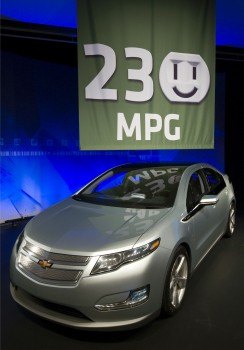Volt Birth Watch 155: The 230 MPG (Alleged) Game Changer
GM announced today that it expects the Volt to receive the first-ever triple-digit EPA rating (including 230 city MPG). GM’s John Lauckner goes into a little more detail at a Fastlane livechat:
Guest: Can you please explain the 230 mpg rating. I must say I balked at your gamble on EREV instead of full hybrid like toyota, but this validates your gamble.
Jon Lauckner: Yes, having a vehicle that achieves triple digit fuel economy is a game changer. The 230 mpg refers to the city fuel economy, but we also expect to have a triple digit combined fuel economy value. These preliminary numbers are based on Volt development testing with our pre-production vehicles and the draft federal fuel economy methodology developed by EPA for EREV vehicles like the Volt.
But, as usual, everything is not what it seems . . .
In fact, even Lauckner seems to admit that the whole 230 MPG hype campaign is a smokescreen. A comment further into the livechat seems to reveal that actual EPA testing may invalidate GM’s day-one Volt slogan of 40 miles without a drop of gasoline. Surprised?
Statik: The EPA rated the Volt at 25 kilowatt hours/100 miles electrical efficiency in city cycle. Does that not now mean with the Volt (which uses approximately 8 kWh of power) the AER in the city is officially 32 miles?
Jon Lauckner: We are still confident that we will deliver 40 miles of autonomous electric range (AER) on both the official EPA city and highway tests, so no change there. The EPA draft methodology reduces the laboratory result take into account a number of factors such as the use of air-conditioning, more passengers in the vehicle, cargo, etc. So, that’s the difference between the “up to 40 miles” that we stated for some time (based on EPA city and highway) and the methodology used by EPA. And, nothing is final until we run an official test which won’t happen for several months.
And with that, Lauckner sweeps aside the curtain of illusion. Testing is not official, nor does it take passengers or air conditioning into account. And when official testing takes place the Volt’s “up to 40 miles” raison d’être could fall.
More by Edward Niedermeyer
Latest Car Reviews
Read moreLatest Product Reviews
Read moreRecent Comments
- Theflyersfan Matthew...read my mind. Those old Probe digital gauges were the best 80s digital gauges out there! (Maybe the first C4 Corvettes would match it...and then the strange Subaru XT ones - OK, the 80s had some interesting digital clusters!) I understand the "why simulate real gauges instead of installing real ones?" argument and it makes sense. On the other hand, with the total onslaught of driver's aid and information now, these screens make sense as all of that info isn't crammed into a small digital cluster between the speedo and tach. If only automakers found a way to get over the fallen over Monolith stuck on the dash design motif. Ultra low effort there guys. And I would have loved to have seen a retro-Mustang, especially Fox body, have an engine that could rev out to 8,000 rpms! You'd likely be picking out metal fragments from pretty much everywhere all weekend long.
- Analoggrotto What the hell kind of news is this?
- MaintenanceCosts Also reminiscent of the S197 cluster.I'd rather have some original new designs than retro ones, though.
- Fahrvergnugen That is SO lame. Now if they were willing to split the upmarketing price, different story.
- Oberkanone 1973 - 1979 F series instrument type display would be interesting. https://www.holley.com/products/gauges_and_gauge_accessories/gauge_sets/parts/FT73B?utm_term=&utm_campaign=Google+Shopping+-+Classic+Instruments+-+Non-Brand&utm_source=google&utm_medium=cpc&hsa_acc=7848552874&hsa_cam=17860023743&hsa_grp=140304643838&hsa_ad=612697866608&hsa_src=g&hsa_tgt=pla-1885377986567&hsa_kw=&hsa_mt=&hsa_net=adwords&hsa_ver=3&gad_source=1&gclid=CjwKCAjwrIixBhBbEiwACEqDJVB75pIQvC2MPO6ZdubtnK7CULlmdlj4TjJaDljTCSi-g-lgRZm_FBoCrjEQAvD_BwE


































Comments
Join the conversation
CamaroKid: "230 is a VERY fair number." No, it's not. It's a bullshit number. With the kind of driving that I do, it'smore like 75mpg. And that's ignoring the likely effects of Minnesota winters. A Volt would save me about $100 per year in fuel costs, if things go well with it. Oh, yeah, baby, sign me up for an extra $18K on the purchase price so I can save $100 a year on fuel. That wouldn't even cover the extra cost to insure and license the thing.
KixStart... How about some specifics about your driving habits to back that up... There are going to be people out there where this car makes no sense... But the FACTS all show that for over 80% of the drivers on the road this car will make atleast 230 MPG and will save THOUSANDS a year in fuel costs. I drive my car like most American's I have a 30 mile round trip commute to work and on the weekend I drive about the same distance... Like most American's this car, for me, would EASILY beat the 230 MPG and I would save over $3000 annually in fuel costs. To only get 75 mpg means that your daily commute would be in excess of 120 miles! You are not anywhere near a normal commuter that puts your annual mileage over 40,000 mile over THREE times the nation average. But lets keep going with this... How much will you save? Depending on what you drive now... if you were switching from a 16 mpg car you would save over $6000 per year. Even if you are switching from a 50 MPG Prius you would still save over $500 a year with a 75 MPG car...